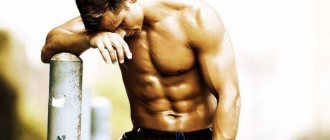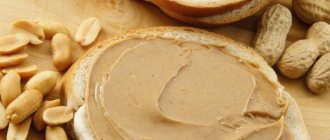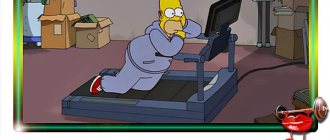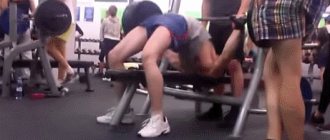Table
There is no precise scientific data to estimate the time required for a full return to sports activities. There are many factors that can affect the result: age, level of load, diseases of the musculoskeletal system, genetics.
But there are personal observations of athletes. Let's try to bring the data together:
| № | Kind of sport | Recovery time, h |
| 1 | Stretching | 24 |
| 2 | Body-building | 48 |
| 3 | Powerlifting | 72 |
| 4 | Martial arts | With general physical fitness – general physical fitness – 48, without – 24 |
| 5 | Strength training | 48 |
| 6 | Cardio training | 24 |
| 7 | Run | 48 |
Increase your sleep time
Lack of sleep is a nightmare for your form. Brazilian scientists M. Dattilo and J. Antunes have proven that lack of sleep and poor quality of sleep can increase weight (“Sleep and muscle recovery: endocrinological and molecular basis for a new hypothesis,” 2011). This happens mainly due to increased hunger and appetite.
It is important not only the amount of night sleep (7-9 hours), but also its quality. To get the most out of your sleep, follow these tips:
- Keep the room temperature cool. Rooms without air conditioning that are located on the sunny side will heat up more in the summer and take longer to cool down. Use fans and cover windows.
- Use blackout curtains, especially in summer when the sun rises early in the morning.
- If noise outside the window or from neighbors prevents you from falling asleep, turn on a recording of nature sounds - they will help you relax.
- Don't forget about the phenomenon of sleep apnea syndrome (sudden cessation of breathing during sleep). This is a common occurrence among bodybuilders and athletes involved in strength sports.
Average time
A simple rule is that the larger the muscle, the more time it will need to rest after training in hours. There are those who are able to return to work within a minimum period of time: abdominal muscles, biceps femoris. The latissimus dorsi muscles take the longest to return to normal. They should not be loaded more than twice a week.
The average time for tissue regeneration is 48 hours.
It is necessary to take into account the fact that the nervous system, ligaments, joints and tendons need restoration.
Useful video on how to recover from a sprain
Often the training process leads to ligament pain, which is the result of injuries.
Strength athletes, football players, basketball players, tennis players and many others are at risk.
Signs of illness
When a sprain occurs, a person feels pain and cannot fully move the joint. In medical practice, there have been cases when the patient after training could not move his arm or leg at all.
Such symptoms cannot be ignored or wait until the ligaments heal on their own; you must go to a hospital for consultation.
Treatment options
To make an accurate diagnosis, the doctor will conduct an examination and take an x-ray. Treatment is prescribed only after all necessary procedures.
The acute period of ligament pain after training is considered to be the first 7-10 days. At this time, the joint needs complete rest, for which a special bandage is applied to the damaged area.
Then treatment includes the following methods:
- Cold or warm compress;
- Phonophoresis;
- Anti-inflammatory drugs;
- Paraffin wraps;
- Radon baths that improve muscle nutrition.
During the rehabilitation period, the patient is shown:
- Massages;
- Therapeutic exercises;
- Medicines that improve blood circulation;
- Muscle relaxation;
- Classes in the pool.
There are no similar articles.
How to catch supercompensation
There are 4 recovery phases:
- Fast.
- Slow motion.
- Super compensation.
- Deferred.
We are most interested in the third point. This is the best time to start a new workout. The body is preparing for increased load, so it actively builds muscle tissue. But how can we determine that this moment has arrived?
Currently there are no exact methods. Perhaps science will eventually be able to determine the hour “X” with an accuracy of the minute. In the meantime, let's try to reason logically. All we have is an approximate average recovery time. It is equal to 48 hours. This means that you need to select intervals through trial and error. But it’s better to take the same two days after training as a basis. You can think something like this:
- Muscles don't grow, but the athlete feels rested ? This means you can reduce recovery time. Moreover, Olympians train 3 times a day and manage to take prizes.
- Muscles are at the same level, but fatigue knocks you down ? It makes sense to increase the pause between classes. For example, up to 72 hours. If progress begins, then everything is going in the right direction.
Muscle tissue increases in volume, but the athlete is constantly under stress? Sooner or later, overtraining will occur. And then a rollback is just around the corner.
1. Consume BCAAs and carbohydrates during exercise
Drinking plain water between sets is essential for proper hydration and body temperature regulation. But adding carbohydrates or amino acids to your water will also improve your energy and well-being.
“Carbohydrates are the main source of energy for your muscles,” says nutritionist Paul Salter. – The harder and more intense you train, the more fuel your body requires in the form of carbohydrates. This is especially true for sports like powerlifting and bodybuilding, where short periods of time under tension are expected.”
But getting energy during exercise is just the beginning. “Carbohydrates have an anti-catabolic function. They minimize muscle breakdown,” Salter writes. – If consumed during training, they will reduce overall muscle damage from exertion. They have a positive effect on recovery time because fewer muscle cells are injured.”
To get maximum benefits, consume the “right” carbohydrates. Fast carbohydrates like glucose, dextrose or carbohydrate sports nutrition products are suitable for us. It is also important to consider the duration of the workout and the amount of carbohydrates consumed so as not to overload the gastrointestinal tract.
Carbohydrate intake during exercise
| Duration of training | Amount of carbohydrates | Amount of water |
| Less than 45 minutes | 0 grams | 500–750 ml |
| 45–60 minutes | 15–30 grams | 500–750 ml |
| 60–90 minutes | 30–50 grams | 750 ml |
| Over 90 minutes | 50–75 grams | 1 l |
Carbohydrates are great on their own, but when paired with branched chain amino acids (leucine, isoleucine, and valine), they become even better. Carbohydrates and BCAAs are designed to reduce muscle breakdown and cortisol levels, which is not the case with plain water. In addition, taking them before or during exercise will reduce post-workout pain.
Most people add about 20 grams of protein powder to their carbs in their post-workout shake. But scientists advise doubling this amount for better protein synthesis and recovery (L. S. McNaughton, “Response of Muscle Protein Synthesis After Fatigue of All Muscle Groups to 40 and 20 Grams of Whey Protein”).
Research has shown that protein synthesis increased by 20% in those who consumed 40 grams of protein. In addition, the improvement in protein synthesis did not even depend on the percentage of body fat in the test subject.
Anatomy
One definition of recovery is the ability to maintain and exceed results in a particular activity. That is, the body must be able to keep pace, overcome stress and adapt to new loads after completing competitions or exercises.
In the first couple of years, theorists of sports medicine proceeded from the concept of homeostasis - the desire to maintain a balance between physiological processes. The body, under normal conditions, wants to remain in balance. But what happens after exercise? Stress hormones are released that disrupt “peace and order.”
Every workout is extreme. But it can be controlled. When an athlete comes to the gym and carries iron for an hour, he exposes himself to stress. The body tries to turn on defense mechanisms and return to normal. Alternatively, protein synthesis begins. This is an attempt to make the muscles bigger and stronger in preparation for future stress.
Cervical osteochondrosis
After or during training, the ligaments may hurt due to cervical osteochondrosis - ossification of soft tissues. The disease equally affects both male and female populations.
Signs of illness
The main manifestations of cervical osteochondrosis include:
- Dizziness;
- Crunch;
- Pain that can be relieved with conventional analgesics;
- High blood pressure;
- Impaired coordination.
If timely treatment is not started, the disease can cause paralysis, which will significantly change a person’s life.
Treatment options
To get rid of osteochondrosis ligament pain after training, an integrated approach is required, including:
- Therapeutic gymnastics;
- Massage;
- Chondoprotectors;
- Vitamin complex;
- Anti-inflammatory gels.
Why do muscles work?
Our muscles do not turn on by themselves, they need an electrical impulse. This means that we cannot do without the autonomic nervous system. It consists of two branches:
- Sympathetic (SNS) . What they call “freeze, fight or flight.” Activation of this branch helps you jump high, run fast, and lift weights.
- Parasympathetic (PNS) . The system is responsible for the digestion of food, the synthesis of new tissues, the process of recovery and rest.
The goal of development is to learn to control the nervous system. If you need to train for a long time and build muscle mass, then you need to “turn on” the SNS. But when the time comes to relax and sleep soundly, healthyly, you can’t go without the PNS.
But how to monitor the balance of the nervous system?
2. Massage roller after workout
Massage is wonderful. But often there is not enough money or time for it, and not many studies have confirmed its benefits for recovery. This does not mean that you should refuse a massage if you like it. For example, R. M. Tiidus in his work “Alternative treatment of muscle microtraumas” recommends massage after training. You can simply resort to a more affordable option, for example, self-massage using a roller.
Over the past few years, research has been conducted on the benefits of myofascial release. A 2015 Canadian study (“Rolling for muscle fatigue and recovery from dynamic exercise”) found that using a foam roller reduced post-workout soreness. The subjects performed self-massage on a roller immediately after training, 24 and 48 hours later.
Someone might think that a massage roller can be replaced with a regular stretch. But that's not true. The 2011 study by R.D. Herbert and M. de Norona, “Stretching as a Way to Prevent Muscle Soreness after Exercise,” found that stretching was ineffective in promoting recovery.
Heart rate variability monitoring
Heart rate variability (HRV) is a change in the interval between two adjacent myocardial contractions. The measurement technique in Russia is promoted by Roman Markovich Baevsky, Doctor of Medicine.
The technology emerged in the 1960s. Scientists analyzed the pulse and cardiogram of the astronauts. As a result, the conclusion emerged that the main indicator of the body is the ability to adapt.
A domestic company is working in the direction of the HRV method, which has developed a special Engy Health application and a professional cardiac sensor Engy Beat. When playing sports, the application shows the current state of the body:
- Energy . It tells how ready the body is for stress.
- Stress . The scale displays your stress level.
- Recovery . Reflects the state of the parasympathetic nervous system.
The smart gadget analyzes the heart rhythm and produces a ready-made, visual result. Like at a traffic light. Green – the body is normal. Red – danger of overtraining.
To connect to the application you need a professional heart rate monitor. Top-end Apple Watch models and devices such as Garmin HRM Dual, Polar H7 and Cardiosport TP3 are suitable.
Arthritis
Often, pain in the ligaments after training occurs due to arthritis. Although everyone is accustomed to the fact that this disease is more common in adults, arthritis progresses. Every year more and more young citizens suffer from the disease, and athletes are no exception.
Signs of illness
Arthritis manifests itself:
- Pain;
- Crunch;
- Decreased limb mobility;
- Deformation.
You cannot put off visiting a doctor, as the disease can lead to disability.
Treatment options
Help relieve ligament pain due to arthritis:
- Anti-inflammatory medications;
- Moderate loads;
- Proper nutrition;
- Pain relieving ointments;
- Plasmapheresis.
Influence of factors
Typically, specialists who develop training schedules take into account 3 factors:
- Age.
- Target.
- Lifestyle.
A young athlete in his 20s experiences little stress. Usually he has plenty of time, no obligations to people and credit institutions. Therefore, an athlete can easily endure high stress and quickly recover from it. But if a person is in his 40s and working tirelessly to support his family, his stress level is high and his ability to recover is low.
Ligament rupture after training
If a tendon is injured during exercise, the ligament can rupture, a serious injury that causes excruciating pain.
People whose activities are directly related to heavy loads, especially athletes, are at risk. During training, athletes repeat monotonous movements a large number of times, so there is always a danger of tearing the ligament.
Ligaments can tear anywhere: elbow, wrist, knee, ankle. The consequence will be the inability to fully move or even disability, and therefore this ailment requires urgent treatment.
Signs of illness
The disease can be recognized by the following signs:
- Pain that appears both during movement and at rest;
- Minor or significant restriction in movement of the injured limb;
- Swelling turning into hematoma;
- Crunching or clicking sounds.
If a person experiences pain in the ligaments and such symptoms after or during training, they should immediately seek advice from a specialist.
Treatment options
Due to the fact that there are several types of ruptures, the doctor selects treatment based on diagnostic studies.
Conservative methods include:
- Bandage that restricts movement;
- Medicines that kill inflammation;
- Pain relievers.
Surgical treatment methods are used only for complete rupture of the ligament. Surgical intervention will help restore the damage 100% if you contact a medical facility in a timely manner. The longer a person delays visiting a doctor, the more likely he is to become disabled.
Dependence on loads
To understand how much effort an exercise takes, you need to monitor the statistics of approaches and repetitions. In this case, the formula for evaluation will be as follows:
Sets x reps x load.
Then two workouts according to the 5x5 scheme will look like this:
- 5 sets × 5 reps × 90 kg = 2250 kg total load.
- 5 sets × 5 reps × 180 kg = 4500 kg load.
It seems that each workout involves 25 repetitions, but the level of fatigue is completely different.
Tendinitis
When you put stress on your arms, the ligaments hurt due to tendonitis, a common disease among active people.
Signs of illness
Initially, pain appears only after training. Over time, she reduces the intensity of her workouts. As a result, a person cannot fully conduct training.
Secondary signs include swelling, redness and decreased mobility of the limb.
Treatment options
To eliminate the disease, the following are used:
- Anti-inflammatory drugs;
- Various ointments;
- Cold or warm compresses.
Run
Using the example of running, you can understand how much time it takes for muscles to recover after training. This sport affects the same muscles. The only difference is additional conditions such as duration and relief.
Running on hilly terrain with ups and downs is especially taxing on the body. This is due to the fact that the muscles need to constantly expend effort on braking and shock absorption. Therefore, the effect of soreness is especially intense.
According to a study published in the British Journal of Sports Medicine, an athlete will need 48 hours to rest before returning to running.
Is it possible to speed up muscle recovery?
It is possible, but not very significant. The speed of muscle recovery greatly depends on genetics, age, overall training experience and a number of household factors. The simplest things help well: sufficient sleep at night, short sleep during the day, a very nutritious diet, taking sports nutrition, self-massage, thermal procedures (baths, sauna, bathhouse), light stretching. But the most powerful factor is proper training planning and a reasonable set of exercises.
You can read more about recovery methods in the article How to recover after a workout
Is it possible to exercise if your muscles are still sore from the last workout? What is the best way to train your body: to the point of exhaustion or often, but little by little? How to restore strength faster. Sechenov effect. Overtraining and how to avoid it
- 2
Tags: muscle recovery, strength training
Training schedule
In most cases, professional trainers recommend guided by your own feelings. Is it hard to work out 4 times a week? This means that you only need to devote 3 days to sports. Otherwise, there will be a risk of falling into a period of constant stress. This is destruction, not growth.
A training week might look like this:
- Monday . Maximum effort. Lower body.
- Tuesday . Rest.
- Wednesday _ Maximum effort. Upper body.
- Thursday . Rest.
- Friday . Moderate effort. Lower body.
- Saturday . Moderate effort. Upper body.
- Sunday . Day off.
At maximum loads, the athlete will be able to train only 2 times a week. Therefore, 48-72 hours of time are needed for muscle recovery. But you still need to wait until the nervous system returns to normal.
Of course, if you work only 2 days and rest the rest of the time, there will be no progress. Therefore, it is impossible without moderate training. They will allow you to stay in good shape.
If the goal is intensive growth of muscle mass, bodybuilding trains using a split system. Then the maximum load should be done on the day when the legs, chest or back “sway”:
- Monday . Legs.
- Tuesday . Rest.
- Wednesday _ Breast.
- Thursday . Rest.
- Friday . Back.
- Saturday . Arms and shoulders.
- Sunday . Day off.
This distribution allows you to work with a minimum level of stress. Groups of muscles recover faster than all muscles at once.
Less common causes of ligament pain after exercise
If a person feels pain after or during training, you should visit a traumatologist. The doctor will conduct an examination, diagnosis, and prescribe appropriate treatment.
Sometimes a consultation with an orthopedist or surgeon may be required.
Sometimes tendons hurt after training for other reasons:
- Unsuccessful classes;
- Incorrect execution technique;
- Excessive loads;
- Lactic acid in muscles;
- Fracture;
- Thoracic osteochondrosis;
- Microtraumas.











